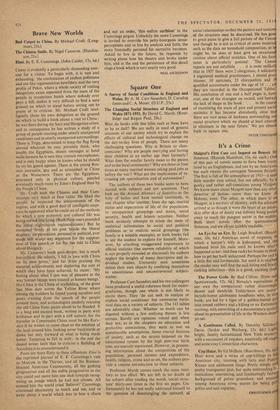Square One
A Survey of Social Conditions in England and Wales. By A. M. Carr-Saunders, D. Caradog Jones and C. A. Moser. (O.U.P., 25s.) WHY do books with fine titles such as these have to be so dull? We are sadly in need of general accounts of our society which try to explain the effects of cultural and technological change on the day-to-day lives of people. There are many challenging questions. Why is Britain so class- conscious? Why are people marrying and having their children at an earlier age than formerly? What does the smaller family mean to the parent and to the local community? Why are three or four times as many married women taking paid jobs as before the war?, What are the implications of in- creasing job specialisation and of automation?
The authors of these two books seem to have started with subjects and not questions. They look on the Annual Abstract of Statistics as the hilly of holies and have moved cautiously, in one chapter after 'another, from the age, marital status and expectation of life of the population, to occupational groupings and status, social security, health and leisure activities. Neither' ' book seriously attempts to relate the mass of statistical information to social and political problems or to realistic social groupings (the family is a notable example), so both books fail tc• stir the student to explore for himself. More- over, by attaching exaggerated importance to official statistics (the uneven reliability of which is not properly revealed or discussed) the authors neglect the insights of many descriptive and in- dividual studies. University men sometimes defeat their own objects by confining themselves to unambitious and uncontroversial subject- matter.
Professor Carr-Saunders and his two colleagues have produced a useful reference book for under- graduates, though one which is not likely to excite them. They 'do not seek to analyse or explain social conditions' but summarise statis- tical data on a variety of subjects. The 143 tables are admirably clear. Whether so much can be digested without a few unifying themes is less certain. Rarely are 'opinions voiced and when they are, as in the chapters on education and protective associations, they seem to rest on questionable assumptions. Some crucial features of society, such as the strains imposed on the educational system by the high post-war birth rate, are scarcely mentioned. However, in present- ing information about the composition of the population, personal income and expenditure, health, religion, crime and so on, the authors pro- vide a concise introduction to these subjects.
Professor Marsh covers much the same terri- tory to less effect. We are left in no doubt of his subject after reading the words 'social struc- ture' thirty-one times in the first six pages. Un- fortunately he has not really addressed himself to the question of disentangling the network of
social relationships so that the pattern and tensio of the structure may be discerned. He has gon to great pains to give a full picture of the Cens and though he is 'not as critical of some materia such as the data on household composition, as h might be, he does at least give an occasions' caution about official statistics. One of his foo notes is particularly pointed : The Censu reports are not infallible . . . it is most unlike] that in 1957 there were 2 clergyman, 4 solicitor 4 registered medical practitioners, 1 dental pra titioner, 10 opticians, 23 chiropodists and 3 qualified accountants under the age of 16 . . . y they are recorded in the Occupational Tables. His conclusion of one and a half pages is, how ever, one of the strangest on record, and betray
the lack of shape in the book : . . in the cours of examining the maze of past and present socia statistics it has become abundantly clear tha there are vast areas of darkness surrounding o social structure which we should at least attem to eliminate in the near future.' We are almo back to square one.


























 Previous page
Previous page